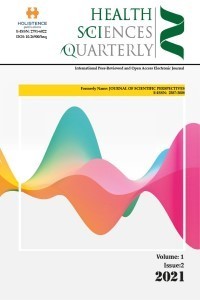First responders’ innovative methodology and curriculum definition for advanced virtual reality training
First responders’ innovative methodology and curriculum definition for advanced virtual reality training
First responders, virtual reality training, curriculum development, step wise approach, androgogy,
___
- 1. Kumar V, Rus D, Singh S. Robot and sensor networks for first responders. IEEE Pervasive Comput. 2004;3(4):24-33. doi: 10.1109/ MPRV.2004.17.
- 2. Benedek DM, Fullerton C, Ursano RJ. First responders: Mental health consequences of natural and human-made disasters for public health and public safety workers. Annu Rev Public Health. 2007;28:55-68. doi: 10.1146/ annurev.publhealth.28.021406.144037.
- 3. Tretsiakova-McNally S, Maranne E, Verbecke F, Molkov V. Mixed e-learning and virtual reality pedagogical approach for innovative hydrogen safety training of first responders. International Journal of Hydrogen Energy. 2017;42(11):7504-12. doi: 10.1016/j.ijhydene.2016.03.175.
- 4. Lee K, Choi H, Cho Y. Becoming a competent self: A developmental process of adult distance learning. Internet and Higher Education. 2019;41:25-33. doi: https://doi.org/10.1016/j.iheduc.2018.12.001.
- 5. Cercone K. Characteristics of adult learners with implications for online learning design. Association for the Advancement of Computing in Education. 2008;16(2):137-59. doi: 10.1090/ s0002-9947-2011-05358-4.
- 6. Kern DE, Thomas PA, Hughes MT. Curriculum development for medical education: a six-step approach. curriculum development for medical education: A six-step approach. 2009. 272 p.
- 7. UPV. Universitat Politécnica de Valencia. 2021. Available at: https://www.upvx.es/
- 8. IVF. Platform Crisis Management. 2021. Available at: https://platformvoorcrisismanagement.ifv.nl/ editie02/welkom/?gclid=CjwKCAjw7J6EBhBDEi wA5UUM2s2C-VGeoPqq_QP2MAR-saoXv5M9z LDrQrYNrKXLfJeuBvvYSt8OVhoCm QwQAvD_ BwE
- 9. CNBOP. Centrum Naukowo-Badawcze Ochrony Przeciwpożarowej. 2021. Available at: https:// www.cnbop.pl/pl/szkolenia/szkolenia-cnbop-pib
- 10. Bomhof L. Experience says it all! Or not? Situation awareness on the fire ground. Master’s dissertation. University of Twente; Netherlands. 2017. Available at: https://essay.utwente.nl/73492/
- 11. Groenendaal J, Helsloot I. The application of Naturalistic Decision Making (NDM) and other research: Lessons for frontline commanders. Journal of Management & Organization. 2016;22(2):173-85. doi: 10.1017/jmo.2015.31.
- 12. Gok K, Atsan N. decision-making under stress and its implications for managerial decision-making : A review of literature. International Journal of Business and Social Research. 2016;6(3):38-47.
- 13. Endsley M.R, Garland D.J. Theoretical underpinnings of situational awareness: a critical review. In: Situation awareness analysis and measurement [Internet]. New York: NJ: Lawrence Erlbaum Associates; 2000:3-32. Available at: https://www.sciencedirect.com/ science/article/pii/S0360319916304013?casa_ t o k e n = l z W w 8 1 _ w M q w A A A A A : o 2 T g F l w b i 9 b c 0 0 9 0 F n U Z l X x z t E A c 03SbbW1raVN1vmQoGvit_5PR8Q0R0I151 PPwvSZ_QTvKkqY doi: 10.1007/978-981-15-1010- 6_2.
- 14. Salomon G. Novel constructivist learning environments and novel technologies: Some issues to be concerned with. Learning and Instruction. 1998;1:3-12. doi: 10.1016/S0959-4752(98)00007-3.
- Başlangıç: 2017
- Yayıncı: Holistence Publications
Zeynep SOFUOĞLU, Débora Pérez ROBLES, Eric DİDDEREN, Federico Rodrigo CARJAVAL, Turhan SOFUOĞLU, Aysel BAŞER, Jóhanna Noraly VEENEKLAAS
Comparison of two different surgical techniques in the treatment of Fournier’s Gangrene
Hasan Anıl KURT, Emre Onur GÜVEN
Mehmet SOYUGÜZEL, Ayşe ERTEKİN, Esra ÖZGÜL
Mustafa TOSUN, Edhem ÜNVER, Ali KÜPELİ, Erdal KARAVAŞ, Sonay AYDIN
An evaluation of patients who present to the emergency department with dizziness
